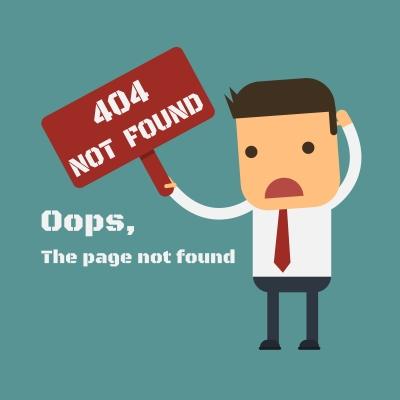
Today I'm going to tell you everything you need to know about 404 errors for your website. If you don't know what a 404 error is, it basically stands for Page Not Found. And, it actually is not a bad thing. So, anything there's a page that's not found on the web, it's completely natural.
Pages get deleted for many reasons, or they break in some cases. But, it's something that you definitely want to keep an eye on.
And, what it is, is a status code that basically tells you that this page is no longer there.
Have A Custom 404 Page
One of the first things you want to know about 404 pages, is that you want to have a custom 404 page. So if somebody goes to a URL that used to exist on your site and it was taken down for some reason, you want them to go to a custom 404 page that returns a 404 status code.
Let me give you an example.
Your 404 page, it might have, in many cases, you'll see somebody puts a cute message on there, or something kind of funny, or link back to the homepage saying "You look like you're lost", or link to a category page or something like that.
In some cases, I've done some really interesting things with 404 page like listed the top sale items that are going on on an e-commerce site right now, or list the special offer, or basically take that same type of things that I would be looking to advertise inside of a homepage banner, or through a pop-up and put it on that 404 page.
I'll tell you this works. The last time I did this, I actually saw a very good jump in conversions in sales as a result of doing it.
So try that with your next 404 page if you're an e-commerce site. This simple test could result in a large increase in sales for you.
With 404 pages, what you really want to watch out for, is that these are not happening without you knowing. And it's not an accident, and it's not because your website broke, or you did a website transfer, and when you did the website transfer, you forget about some URLs and didn't 301 redirect them.
404 errors that are not done on purpose can be really bad and devastating for your website. I was working with this one large e-commerce site recently.
And this large e-commerce site, every month they'd have a new batch of another hundred 404 errors. And, it just kind of kept happening and happening and this was bad.
Becuase those URLs had rankings. And if those URLs have a ranking, and they're 404ing, then you're going to be losing more and more traffic over time. So, you don't really want to have 404s if you can avoid it.
The way that search engines work, and general websites online that take other people's information and display it, is they want to have URLs they can rely on.
Whether it's Facebook or Twitter, google, bing, yahoo, you name it, they don't want a link to broken pages, and 404 pages.
The longer a page is on the internet, the more that it's updated, the more credibility that it has, the higher it's going to rank, and more traffic it's eventually going to accrue.
You really got to watch out for that for 404 pages and make sure that, especially if it's after a website transfer, or if they seem to be kind of happening for no reason, that you get to the bottom of it quick.
A couple other things about 404 errors. If you want to find out if you have them or not, you can go inside a Google Search Console.
There's a great report that shows you if you have 404 errors. That same report will allow you to click on that page and see how many people have linked to that potential 404 page.
And that can be really important too. You don't want 404 pages that had a lot of traffic or had a lot of backlinks to them. Becuase those backlinks help the overall rankings of your website, and you might want to redirect those somewhere else.
Or just keep that url alive, because maybe you have an internal link from there to another page to push that higher.
You can see your 404 errors inside a Google Search Console, that's a great place to look. Outside of the, you can run third-party tools like Screaming Frog, Xenu's Link Sleuth, SEMrush, DeepCrawl, the list goes on, to determine where your 404s are on your website.
That's it for 404s today, hope you learned something. There's a lot to be said about it, mostly because the term 404 bleeds over into a lot of other issues that arise around 404s.
So, keep an eye on them. Hopefully, you don't have too many. If you do have some, and it' done because you did it on purpose, that's totally fine.

